Customer input and experience is crucial to product design, check out this article to see how important the customer experience is to product development.
Product Design
They say the customer is always right – but is the old saying true? When it comes to product design, the answer is yes.
Customer experience is crucial to product design and development. If your customers don’t like your products, you’ll quickly lose them, unless you make changes. However, a company that’s always working to create better products tends to have loyal customers.
How is customer experience used to inform product design? In this guide, we’ll break down everything you need to know – keep reading to learn more.
Why Customer Experience Matters
At the end of the day, it could be said that customer experience is the only thing that your company should care about.
You can do everything else right, but if customers find the experience with your product lacking, that product won’t succeed. On the other hand, the most successful businesses in the world seamlessly incorporate customer experience into their design strategies.
Why Let Customer Experience Influence Product Design?
Let’s take a closer look at why your customers’ experiences should affect product development at your company.
1. Customers Have More Access to Information
In this digital age, customers can easily get information from other customers. Reviews and ratings are easy to find, so if your product doesn’t provide a desirable experience to your current buyers, other consumers will quickly find out.
2. Consumers Have High Expectations
With more choices than ever before, it takes more to impress consumers. Experience goes a long way toward beating out the competition. People are also likely to trust the word of their peers. If your design positively impacts experience, those good reviews will go a long way.
3. Retaining Customers is Cheaper
Finding new customers once you’ve lost a large pool of existing ones gets expensive. Getting new customers is almost always more expensive than keeping your current ones. It’s much easier to keep the customers you have than to try to rebuild.
Of course, it’s still valuable to invest in attracting new customers. But you also need to be sure that you’re invested in keeping the ones you have – designing products to maximize experience is a great way to do this.
4. You Can Easily Research Customer Experience
It’s much easier to gather data on customer experience than it once was. With all this information available, why wouldn’t you use it to influence product design?
Customers are interacting with your company in multiple ways. They might be contacting customer service about an issue with your product, using an online chat system on your website. You can use recorded chats to find recurring issues, and fix them in a product update.
5. Experience Equals Satisfaction
Better customer experience means more customer satisfaction, period. Increase satisfaction, and you get happier and more loyal customers.
6. Satisfied Customers Mean More Sales
All of this translates to more money for your customers. Designing products with customer experience in mind means that they will come back to make more purchases and share the news about your product with other potential customers.
This makes you competitive in your industry and provides you with opportunities to grow your brand more.
How to Use Customer Experience in Product Design
Now, you can see why customer experience is so important when it comes to product design. But how exactly can you put this information to good use at your company? Let’s break it down.
1. Consider Experience During Development
Many companies have released products, only to go back and use information about customer experience to update and redesign.
This is a backward approach. Instead, you need to consider experience during the development stage of the product. This saves time and money, allowing you to get products right the first time.
2. Base Design on Customer Needs
In order to properly influence design, you need to have a solid working knowledge of what your customers’ needs are. It’s not enough to guess at what you think their needs will be – you need to gather accurate information. In the digital age, this is easy to do.
It’s tempting to think that customer needs have always driven design, but that’s not actually the case.
Many companies have based product design on the demands of a few investors or influencers, rather than on the needs of their customer base as a whole. At other times, design has been driven by what products competitors are putting out, rather than by what customers really want.
After launch, many products are updated or given “improvements” that aren’t based on actual customer needs or wants. When design teams don’t communicate with support and customer service teams, products can be produced and updated at a high rate, but the business can still suffer.
3. Use Customer Touchpoints During Development
The focus of product development shouldn’t be on getting the product to market as soon as possible. This approach skips the important step of finding out what customers really want.
Instead, incorporate customer touchpoints throughout the entire development process. Make changes accordingly. Plan ahead for potential issues and use early testing to find out if your product provides the right experience.
User Experience (UX) design and constant iteration during development will make the customer experience better in the future.
4. Shift Focus Away From the Initial Sale
Of course, selling products in the first place is important. However, many businesses focus on making the initial sale alone, without considering the experience that will follow.
This leads to few repeat customers since the experience after the sale is likely to be subpar. Your goal should be to get products into customers’ hands. But an equally important goal needs to be designing those products to keep customers happy long after they’ve made the purchase.
If the customer experience is lacking, show that you recognize that by offering updates and new features to address those pain points. Customers are likely to stay loyal if they see that your company cares enough to work on a fix.
How Will You Change Product Design?
The exact approach to pairing design with experience will depend on your niche. However, no matter what you’re selling, you need to make sure it’s offering an experience that meets or exceeds expectations.
What will your company do to incorporate customer experience into your designs? Schedule a free consultation and reach us today!


